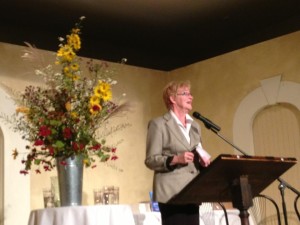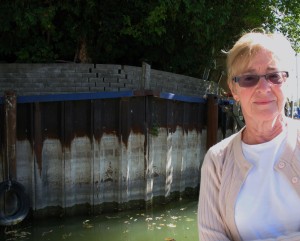The Greatest Threat to the Great Lakes and No One Seems to Know About It: Expanding Enbridge’s Line 5 Through the Straits of Mackinac
Click here to read and download PDF
How often do you hear a story in the news and then feel utterly shocked that you didn’t know anything about it? Well, that’s how all 40 million of us living in the Great Lakes should feel about the Enbridge Line 5 expansion across the Straits of Mackinac—a pipeline expansion project that will transport tar sands oil directly through the heart of the Great Lakes. In a nutshell, this just may be the greatest threat facing the Great Lakes at this time in history. “An oil spill in the Straits of Mackinac isn’t a question of if—it’s a question of when,” according to National Wildlife Federation’s (NWF) comprehensive report on this issue, Sunken Hazard.
What would a tar sands oil spill the size of Exxon-Valdez mean for the Great Lakes? Goodbye fisheries, aquatic food links, goodbye wildlife, goodbye municipal drinking water, goodbye Mackinac Island, goodbye tourism and property values, and goodbye to one of the world’s largest freshwater inland seas.
What company is stealthily completing this hazardous energy venture with limited public scrutiny? Enbridge—the same Canadian company responsible in 2010 for a million gallon tar sands oil pipeline rupture and a $1 billion cleanup along a 35-mile stretch of Michigan’s Kalamazoo River. Known as the largest transporter of crude oil, Enbridge is requesting a permit from the State Department’s U.S. Transportation Department’s Pipeline and Hazardous Materials Safety Administration (PHMSA) to expand its existing pipeline—Line 67 also known as the Alberta Clipper—to transport heavy tar sands oil originating from Alberta, Canada to Superior, Wisconsin. From there, Enbridge, according to company officials, has already expanded the capacity of a second existing pipeline—Line 5—that travels directly through the Straits of Mackinac to a refinery located in Sarnia, Ontario. The 1,000+ mile Alberta Clipper pipeline route will double the tar sands oil that it currently carries and will deliver even more tar sands oil than the highly publicized and controversial TransCanada Corp’s Keystone XL pipeline.
Built sixty years ago in 1953, Line 5’s twin pipelines that cross the Straits of Mackinac—each 20 inches in diameter—were designed to transport light conventional crude oil, not Enbridge’s viscous, heavy tar sands oil or “bitumen” blended or diluted with volatile natural gas liquid condensate, also known as “dilbit.” Dilbit spills are particularly difficult to remediate because the bitumen and diluents separate, releasing toxic volatile organic compounds (VOCs) and heavy, sticky bitumen material. And in Lake Michigan, who knows how long it would take to actually clean up these pollutants. The National Oceanic and Atmospheric Administration (NOAA) estimates that it takes an average of 99 years to rid of pollutants in Lake Michigan.
Now let’s dig a little deeper into Enbridge’s depressing track record. According to NWF, “Enbridge’s pipelines had more than 800 spills in the U.S. and Canada between 1999 and 2010, leaking 6.8 million gallons of oil.” So with the combination of strong currents along the Straits, Enbridge’s inexcusable track record, its weak emergency response, and a strong likelihood of mechanical pipeline failure in this fragile ecosystem, we must ask ourselves: is this a risk we as citizens, inheritors, and future protectors of the Great Lakes are willing to accept?
This Enbridge pipeline expansion is a perfect example of why we have the public trust in our navigable waters—an ancient legal doctrine dating back to the Roman times—designed to protect our common shared resources like the Great Lakes. The public trust empowers us as a democratic and thoughtful people to question the impacts of proposed actions like Enbridge’s and determine whether they will impair, pollute or irreparably harm our water resources, and jeopardize protected water uses like fishing, swimming, and navigation.
This proposed action is a clear violation of the public trust as the pipeline threatens to destroy the Great Lakes’ common waters, which support the region’s $62 billion economy with 1.5 million jobs, drinking water for 40 million citizens, as well as our very social fabric, quality of life and enjoyment, and shared ecosystem with wildlife. The unprecedented scale of such an ecological and economic disaster also would undermine the $1 billion already invested in the U.S. government’s Great Lakes Restoration Initiative. This is why the public trust and its protection of the commons is more important than ever.
What this debate really boils down to is a much-needed larger national conversation about our country’s future energy policy. Not only does President Obama need to have the Keystone XL pipeline on his radar, but all pipeline expansions like this project, in assessing the impacts of climate change. It’s time that our nation makes good energy choices that respect the Great Lakes as a shared common resource protected by the public trust. We need to put the safety of our water and our future generations before our overzealous energy development. If we do this, we can chart a future with clean and abundant water, food, energy and a prosperous economy.
Looking for something concrete to do about this pressing pipeline issue? Come join FLOW, TC350, 350.org, National Wildlife Federation, Michigan Land Use Institute, Food & Water Watch, and many other organizations and attend the Oil and Water Don’t Mix: A Rally for the Great Lakes on July 14th at the St. Ignace Bridge View Park, just north of the Mackinac Bridge. The purpose of the rally is to bring attention to the dangers of this pipeline and its expansion, and to organize a response to these risks. We want to pressure our leaders to put safety measures in place to prevent a devastating oil spill in the heart of the Great Lakes. Click here to sign up and RSVP via this Facebook event.





